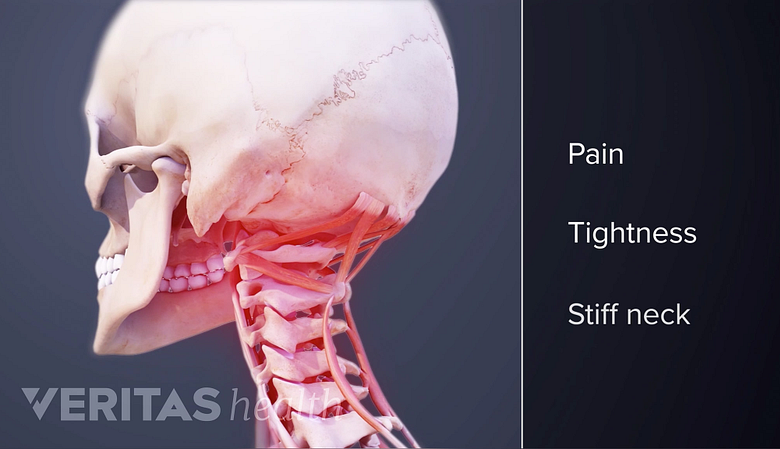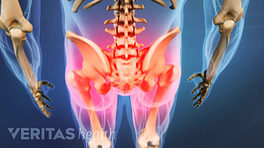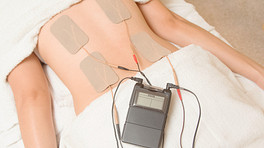The most widely used type of electrotherapy is transcutaneous electrical nerve stimulation or TENS.
In This Article:
- All About Electrotherapy and Pain Relief
- How Electrotherapy Works to Ease Pain
- Transcutaneous Electrical Nerve Stimulators (TENS)
- Percutaneous Electrical Nerve Stimulation and Electrical Muscle Stimulation
- Other Electrotherapy Treatments
What to Expect with TENS Therapy
TENS therapy typically uses electrodes on small, sticky pads attached via wires to a battery-operated device. The electrodes are placed over the area in pain, and current is sent through the electrodes, stimulating the sensory nerves and creating a tingling sensation that reduces the feeling of pain.
A hand-held controller allows the individual to select from a range of options, such as high frequency or low frequency current as well as complex patterns of stimulation.
People are often introduced to TENS therapy during physical therapy or in a chiropractor's office. This gives the individual the opportunity to see whether pain relief is sufficient to consider purchasing a TENS unit for home use.
See Chiropractic Services Beyond Adjustments
In recent years, a number of TENS products have been marketed as wearable devices. Some of these devices deliver current directly from electrodes in a battery-powered unit worn on the body. The unit may be strapped to a leg or attached to the back, shoulder, knee, or other part of the body. These devices are typically not visible under clothing.
Therapy may be done in 30-minute segments or run continuously. Overnight therapy is possible in some cases.
The response to TENS varies widely. While many individuals consider TENS a key part of their treatment, TENS does not relieve pain for everyone.
Conditions Treated with TENS
TENS therapy alleviates neck pain and stiffness.
Conditions responding well to TENS include, but are not limited to:
- Neck pain and stiffness. Pain was reduced in severity over the short term in a study of people treated at several clinics who were provided TENS therapy. 1 Escortell-mayor E, Riesgo-fuertes R, Garrido-elustondo S, et al. Primary care randomized clinical trial: manual therapy effectiveness in comparison with TENS in patients with neck pain. Man Ther. 2011;16(1):66-73.
- Low back pain is often treated with TENS, but the research has been conflicting. 2 Johnson M, Martinson M. Efficacy of electrical nerve stimulation for chronic musculoskeletal pain: a meta-analysis of randomized controlled trials. Pain. 2007;130:157-165. , 3 Kroeling P, Gross A, Graham N, et al. Electrotherapy for neck pain. Cochrane Database Syst Rev. 2013;(8):CD004251.
- Diabetic nerve pain was reduced significantly for people who had TENS therapy in three medical studies analyzed. The effect lasted six weeks after the studies, but did not continue at the 12-week follow-up. 4 Jin DM, Yun X, Deng-Feng G, Tie-bin Y. Effect of transcutaneous electrical nerve stimulation on symptomatic diabetic peripheral neuropathy: a meta-analysis of randomized controlled trials. Diabetes Res Clin Pract. 2010;89:10-15 as cited in AAN Summary of Evidence-based Guideline for patients and their families: Therapies for Treating Diabetic Nerve Pain. American Academy of Neurology, 2011.
- Fibromyalgia pain. Tolerance during physical activity significantly improved for patients after a single TENS treatment in one research study. 5 Dailey DL, Rakel BA, Vance CG, et al. Transcutaneous electrical nerve stimulation reduces pain, fatigue and hyperalgesia while restoring central inhibition in primary fibromyalgia. Pain. 2013;154(11):2554-62.
TENS is typically applied at the site of the pain, but is sometimes effective when used in other areas as well. Experimenting with various electrode placements and using a TENS unit for several days is recommended before buying a unit. Attaching electrodes in the area surrounding the site of the pain, over the nerve supplying the area in pain, or even on the opposite side of the body, may be useful.
- 1 Escortell-mayor E, Riesgo-fuertes R, Garrido-elustondo S, et al. Primary care randomized clinical trial: manual therapy effectiveness in comparison with TENS in patients with neck pain. Man Ther. 2011;16(1):66-73.
- 2 Johnson M, Martinson M. Efficacy of electrical nerve stimulation for chronic musculoskeletal pain: a meta-analysis of randomized controlled trials. Pain. 2007;130:157-165.
- 3 Kroeling P, Gross A, Graham N, et al. Electrotherapy for neck pain. Cochrane Database Syst Rev. 2013;(8):CD004251.
- 4 Jin DM, Yun X, Deng-Feng G, Tie-bin Y. Effect of transcutaneous electrical nerve stimulation on symptomatic diabetic peripheral neuropathy: a meta-analysis of randomized controlled trials. Diabetes Res Clin Pract. 2010;89:10-15 as cited in AAN Summary of Evidence-based Guideline for patients and their families: Therapies for Treating Diabetic Nerve Pain. American Academy of Neurology, 2011.
- 5 Dailey DL, Rakel BA, Vance CG, et al. Transcutaneous electrical nerve stimulation reduces pain, fatigue and hyperalgesia while restoring central inhibition in primary fibromyalgia. Pain. 2013;154(11):2554-62.











